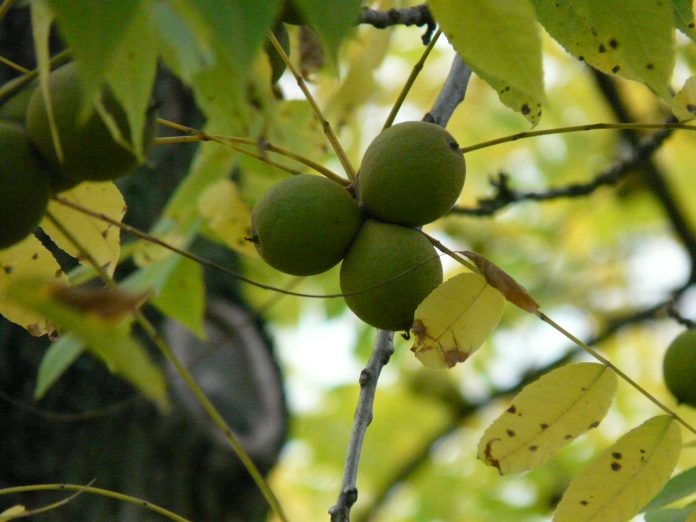During the fall, there’s plenty to forage for in Ohio. Last week I listed some of Ohio’s most delicious native fruits, so I thought I’d follow up with some of the most common nuts foragers look for during the fall.
Keep your eye out for these five native nuts this fall while you’re out foraging.
Black Walnut
Native black walnuts start dropping off of trees from September through October. Once they fall to the ground, they should be harvested as soon as possible.
Where they grow. Black walnut trees prefer deep, moist, rich, well-drained soil. They are most commonly found in bottomlands and open fields but can be found all over Ohio thanks to squirrels burying and forgetting about its nuts.
What they look like. Black walnut trees can grow up to 70 feet tall with a 70-foot spread. They are upright and rounded in shape. They have long alternate, compound leaves with 11 to 23 leaflets on each. The bark is brown-grey to brown-black with a flaky texture in youth and becoming more rigid and deeply furrowed with age. The fruit is very easily identified, as it is surrounded by a thick outer husk — green in appearance before its ripe and yellow-black when mature.
Uses. The nutmeats are edible. People eat them plain or salted. They can be preserved or, if you like to bake, used in a number of dessert recipes.
American Hazelnut
Hazelnuts mature in early autumn.
Where they grow. Hazelnut shrubs are found throughout Ohio along roadsides, in fields, at the edges of deciduous woodlands and in fencerows, in dry or moist sites.
What they look like. Hazelnut shrubs are pretty large, growing up to 15 feet tall with a rounded 15-foot spread. Its leaves are alternate, serrated, short-petioled and oval in shape with a narrower base. Their bark is shiny olive brown. The fruit is wrapped in an outer papery husk that covers one inner nut. When you harvest them, check under the branches as the nuts tend to hide under the leaves.
Uses. You can eat hazelnuts while the shells are still green if they have a developed nut inside. You might also dry the nuts you’ve collected and roast them later.
American Beech nut
American Beech nuts reach maturity from late summer to early fall. Their outer, prickly hurts will split open to reveal two triangular, edible nuts called “beech mast.” However, you should note this only happens once in a while. Although Beech trees produce casings every year, the husks only have full nuts every 3-5 years.
Where they grow. The American Beech is found throughout Ohio. It is frequently found growing naturally on lower slopes that drain into streams.
What they look like. Although they are slow growing trees, they can grow up to 80 feet tall with a spread of 70 feet. Its leaves are alternate with coarse serrations. They start out silvery-green in the spring and darken into the growing season. They bark is one of their most distinguishing traits, steel grey in color, thin and very smooth. Beechnuts are composed of an outer, prickly husk with two triangular nuts inside.
Uses. You can dry roast beechnuts in the oven or cold press them to extract the oil if you have a lot.
Acorns
Acorns ripen and drop from early to mid fall.
Where they grow. There are 600 species of oak worldwide and North America actually contains the largest number of oak species. What I’m saying is oak trees are abundant and acorns should be one of the easier items on the list to find. Ohio has 13 native species to choose from, including Red Oaks: Black Oak, Pin Oak, Red Oak, Sawtooth Oak, Scarlet Oak, Shingle Oak and Shumard Oak; White Oaks: Bur Oak, Chestnut Oak, Chinquapin Oak, English Oak, Swamp White Oak, White Oak.
What they look like. Although the various species of oak can have vastly different characteristics, across for the most part are easily distinguished. Acorns are easily identified because of their caps. The nuts can be green or brown, large or small, but every single acorn variety will have a cap.
Uses. Eating acorns that contain too much tannic acid can cause digestive upset. To remove the bitter-tasting acid, crack your acorns into pieces and soak the nut meat chunks in repeated baths of warm water for one hour. Repeat this process until the bitter taste is gone. White Oaks and other round-lobed varieties will have the lowest level of bitterness.
Butternut (White Walnut)

Like its cousin, the black walnut, butternuts come into season from September through October.
Where they grow. The butternut is slower growing and more sparsely spread throughout Ohio than black walnut trees. It is more common in the eastern part of Ohio, growing in moist bottomlands and ravines.
What they look like. Butternut trees can grow to 60 feet tall and 50 feet wide. Its elongated nuts, hairy stems and flattened, shiny ridges on mature trees make it recognizable as a different species than the black walnut. Like the black walnut, butternut leaves are alternate and pinnately compound. They are distinguished from the black walnut by being longer with fewer leaflets. The tree’s bark is light gray and smooth when young, but fissures into distinctly flat-topped ridges that are a shiny silvery color as it matures. The White Walnut name comes from the appearance of its mature bark. Butternut fruit is similar in appearance to black walnuts; however, it’s shape is more oblong and its color is slightly darker.
Uses. Butternuts are sought after for their sweet, buttery taste.
Related Content
- Foraging for black walnuts: How to find and gather black walnuts
- How to make wood stain from black walnut hulls
- How to harvest, process and store black walnuts
- How to forage for native Ohio fruit this fall














Enjoyed the article on nut foraging.